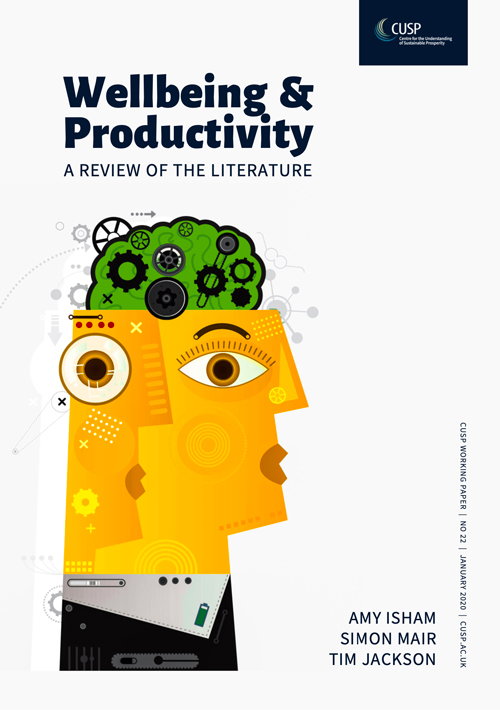The UK is currently facing two inter-related socio-economic challenges. One is the now well-documented ‘productivity puzzle’; the crisis of persistent low productivity growth across the economy. The other is low levels in the mental and physical health of the working population, in particular. Wellbeing has been considered as a driver of higher levels of productivity and thus a means of solving the productivity puzzle. However, the relationship between productivity growth and wellbeing is complex and involves many moderating or mediating factors.
This report reviews the relationships between the different aspects of wellbeing, productivity, and productivity growth. It is the culmination of a desk-based evidence review, survey, and a mapping workshop held with experts from backgrounds including psychology, sociology, economics, and design. The focus is on wellbeing and labour productivity, although resource productivity and multi-factor productivity are also touched upon at relevant points within the report. Key findings and recommendations for further research are summarised below.
Key finding 1
Wellbeing is linked to higher levels of labour productivity.
- Individuals who have been diagnosed with a chronic physical health problem and those who engage in risky health behaviours (e.g. smoking, unhealthy diet, and lack of exercise) in the absence of any formal diagnosis both tend to report reduced labour productivity through presenteeism and absenteeism.
- Poor mental health appears to be more strongly linked with lost productivity through presenteeism (relative to absenteeism), as people are often reluctant to disclose that they are suffering from mental health problems.
- Higher levels of subjective wellbeing has been linked to greater labour productivity, and the causal nature of this link has been demonstrated in experimental studies.
- High levels of stress can lead to burnout and reduced labour productivity, but training resilience has been shown to produce positive effects on wellbeing and productivity.
- Case studies demonstrate that workplace wellness programmes can deliver benefits in terms of enhanced productivity, but this seems to be reliant on certain conditions being met (e.g. tailoring to the specific organisation and senior management support).
Key finding 2
Certain factors may be able to explain the positive relationship between levels of wellbeing and labour productivity.
- Human capital is an asset that is considered to enhance an individual’s or organisation’s productivity. At the same time, it can enhance wellbeing by facilitating the satisfaction of psychological needs, greater health status and greater social mobility.
- Social capital allows for voluntary cooperation and the effective sharing of human capital, thus heightening productivity. At the same time, it considered to be a determinant of higher levels of wellbeing in the workplace and everyday life.
- Certain environmental factors have been linked to both greater wellbeing and greater labour productivity. These include air quality, greenery and temperatures.
- Information and communication technology (ICT) has been considered as a key driver of productivity growth and has the potential to support wellbeing in that it facilitates communication, autonomy, and more flexible working conditions.
Key finding 3
Productivity growth may have detrimental effects on wellbeing.
- Attempts to reduce costs and increase labour productivity within the healthcare sector can lead to poorer quality care being provided and thus poorer health outcomes.
- The pursuit of productivity growth in the workplace can heighten a number of workplace factors such as job demands and job insecurity, both are associated with poorer wellbeing.
- Although the adoption of ICT can promote productivity growth, it can also blur the boundaries between work and home life and facilitate sedentary lifestyles, hence reducing wellbeing.
- Sustained productivity growth may increase carbon emissions, raise average temperatures, and deplete forms of natural capital that have been shown to be beneficial for wellbeing.
We conclude that, although wellbeing may be a determinant of higher levels of productivity, the way in which we pursue productivity growth also appears to have the potential to undermine wellbeing. Our key recommendation is therefore for research that takes a critical approach to understanding how wellbeing and productivity growth may influence each other over time and across contexts. Numerous suggestions for specific areas for future research have been made throughout the review and these are summarised in Table 1 (PDF). Once we have a more nuanced understanding of the relationship between these two factors we will be better able to decide upon the value we assign to productivity growth and if and how we wish to pursue it.
Download
- Download
 full paper (pdf, 2.9MB) | Isham A, Mair S and T Jackson 2020. Wellbeing and productivity: A review of the literature. CUSP Working Paper No 22. Guildford: University of Surrey.
full paper (pdf, 2.9MB) | Isham A, Mair S and T Jackson 2020. Wellbeing and productivity: A review of the literature. CUSP Working Paper No 22. Guildford: University of Surrey. - This publication is part of the ESRC funded Powering Productivity project. For details, pelase see the CUSP website.







